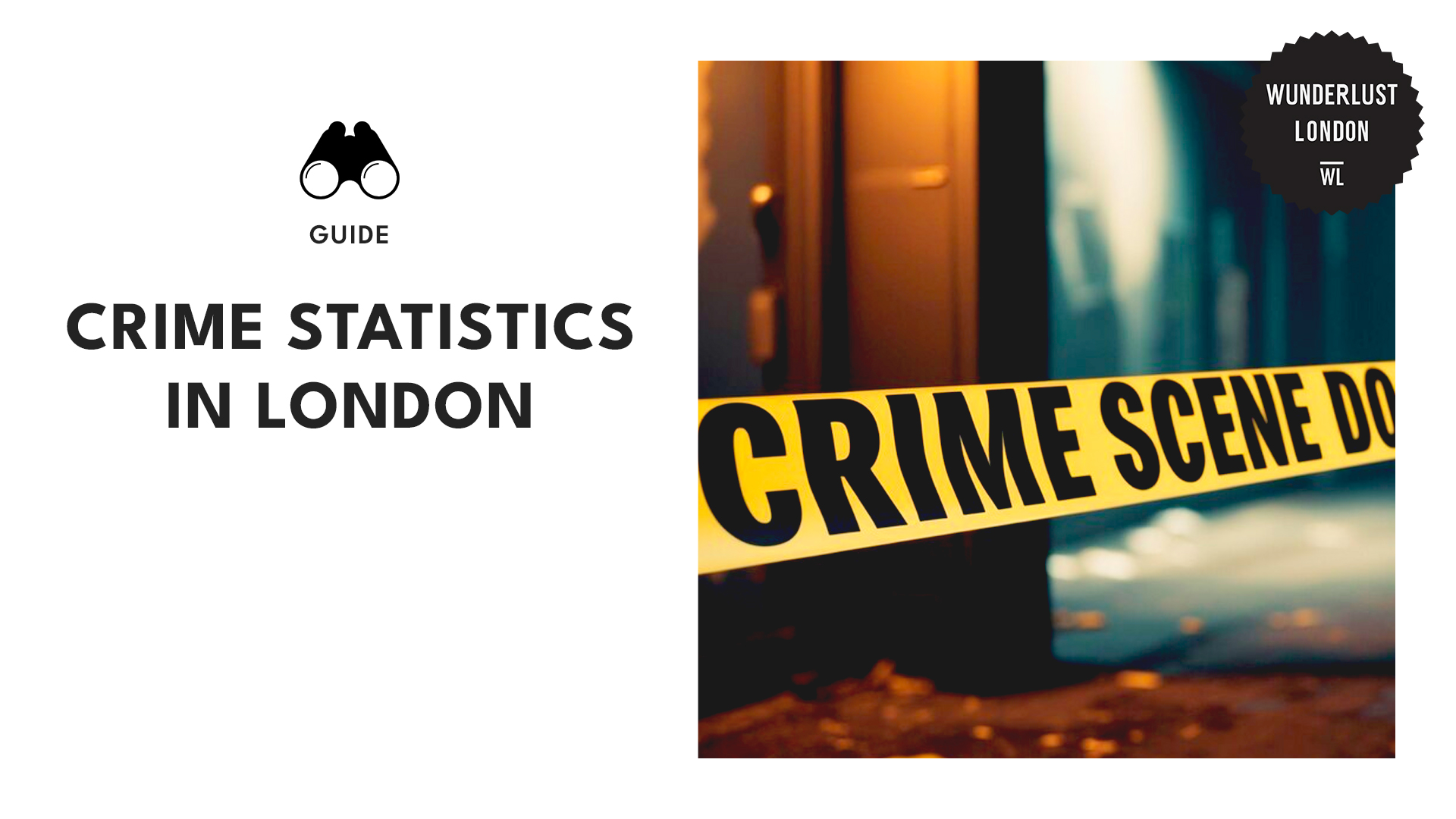Key insights
- According to Statista, crime rates in London increased between 2015 and 2019, reaching their peak in 2018-2019 with 912,487 reports.
- Statista observed a decline in crime rates in 2020-2021 due to the impact of pandemic restrictions, followed by a surge post-pandemic.
- CrimeRate reports that violence and sexual offences are the most frequent crimes, with 29 per 1,000 people reporting incidents.
- The Sentencing Council of London has a range of sentences that vary widely by crime, from community orders to life imprisonment, depending on the severity and type of crime.
- According to CrimeRate, Newham and Hackney have the highest crime rates, while the City of London and Richmond upon Thames have the lowest.
- The Ministry of Justice reports that males represent 85% of arrests and 96% of the prison population.
London has experienced fluctuations in crime rates over the years. According to data from Statista, crime rates generally increased from 2015 to 2024, with notable variations during this period.
There was a steady increase in crime between 2015 and 2016 but it has reached its highest levels in 2018 and 2019 with 912,487 reports.
A decline was observed in 2020 and 2021, with 746,126 reports. It can likely be attributed to the impact of pandemic-related restrictions, which reduced opportunities for criminal activity.
Following the easing of restrictions, crime rates saw a significant resurgence. This culminated in 938,020 reported offences from 2023 to 2024.
The chart below provides a detailed illustration of the crime trends in London from 2015 to 2024, as recorded by the police.
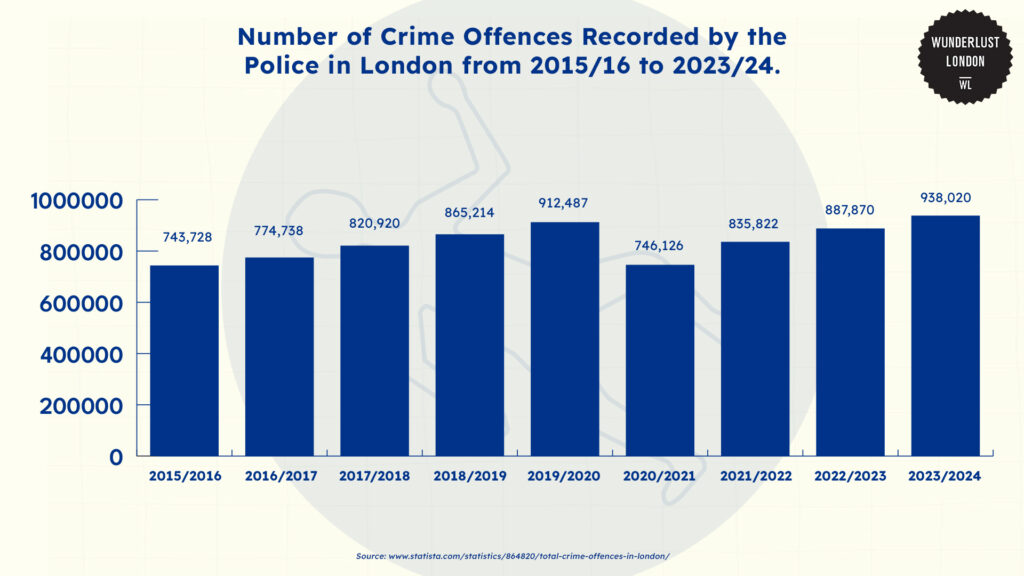
Compared to pre-pandemic levels, some crime categories have not fully rebounded to their 2019 to 2020 figures.
Crime trends and patterns in London
Highest crime rates in London
The CrimeRate data focuses on specific types of crime in London, excluding broader categories like anti-social behaviour and bicycle theft because they aren’t specific enough for this analysis.
- Theft from person: 22.79
- Robbery: 6.72
- Vehicle crime: 2.85
State CrimeRate as the data source.
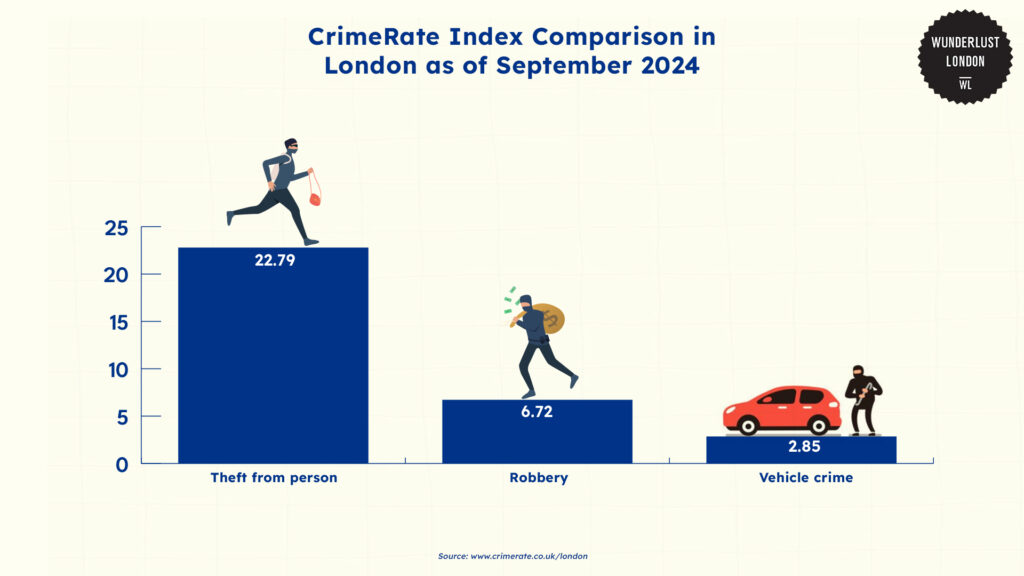
According to 94,133 crime reports logged by the Metropolitan Police during the 12-month period ending September 2024, theft-related crimes in London are notably high.
Theft From the Person offences are 23 times above the national average. Robbery crimes also have elevated rates, but they are lower than theft.
Over time, this suggests that theft and personal crimes are more prevalent in London than other crime types. Vehicle crime, though still significant, appears to be somewhat less common in comparison.
Largest 3-year increases in crime types in London
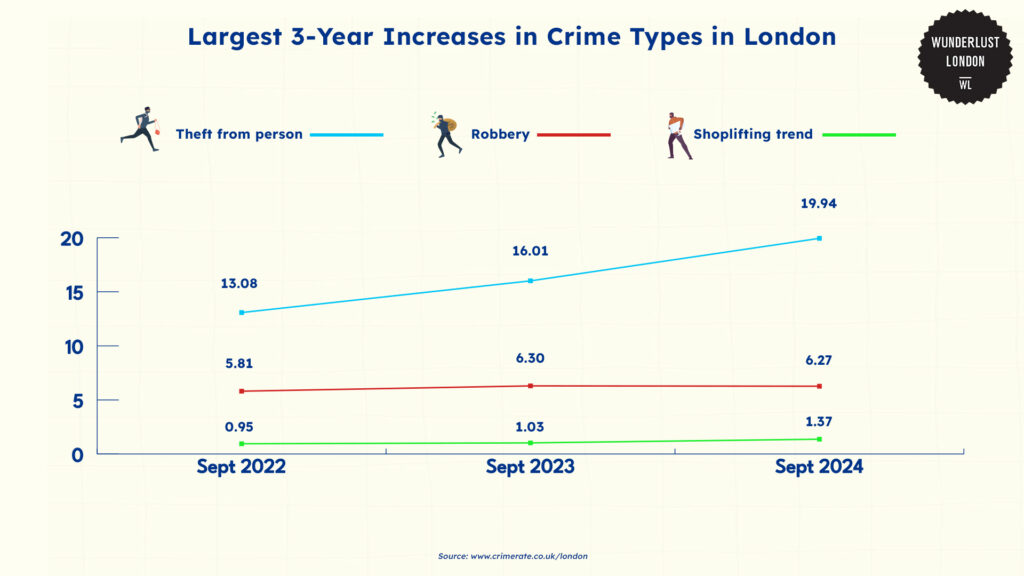
Based on CrimeRate’s data, certain types of crime—particularly theft from the person, robbery, and shoplifting—are rising noticeably, surpassing the national average.
Theft from the person has seen the most significant increase. It suggests that incidents like pickpocketing or snatching are becoming more frequent. This could point to growing concerns about personal safety or more targeted, opportunistic crimes in certain areas.
Though rising at a slower pace, robbery still shows an upward trend. This may reflect increasing levels of violent or aggressive thefts.
Shoplifting is also on the rise, which could be influenced by factors such as economic hardship or changing retail environments.
Largest 3-year decreases in crime types in London
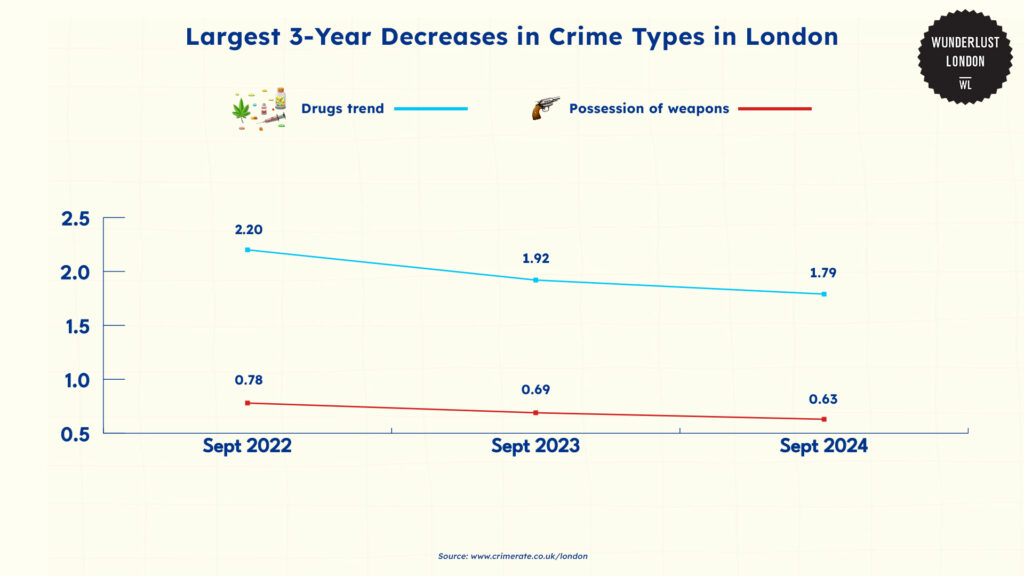
The trends indicate a decline in both drug-related crime and possession of weapons compared to the national average, as per CrimeRate’s data report.
Drug-related crime has decreased by around 19% over the past three years, while possession of weapons has fallen by about 32%.
These declines suggest improvements in crime prevention and possibly stronger law enforcement or societal changes.
Sexual offences
Sexual offences in London have seen a notable rise from 2021 to 2022. It surpasses figures from previous years, particularly following the pandemic: Sexual offences statistics in London
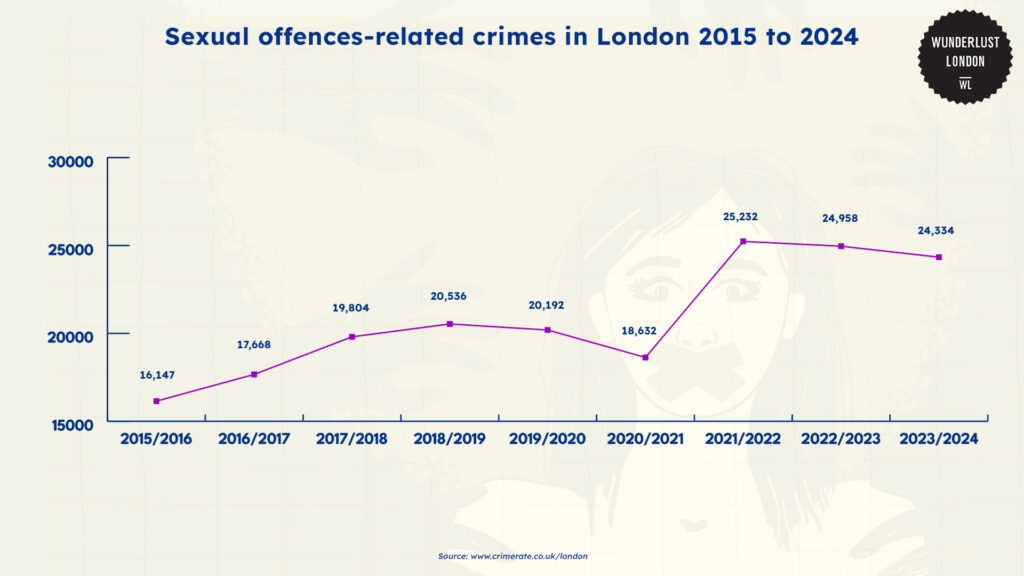
In the 2023 to 2024 period, Statista revealed that London recorded 24,334 police-reported sexual offences. This represents a slight decrease from the 24,958 cases reported in the previous year.
Although the number of reported cases in 2023 was slightly lower than in 2022, the steady increase from 2018 suggests a growing awareness of sexual violence and a shift towards more victims coming forward.
This increase, particularly in cases involving minors, highlights an ongoing concern for the safety of vulnerable groups.
However, the persistent issue of under reporting continues to suggest that the true scale of sexual violence may be even greater than what the statistics show.
Crime rates reported by boroughs in London
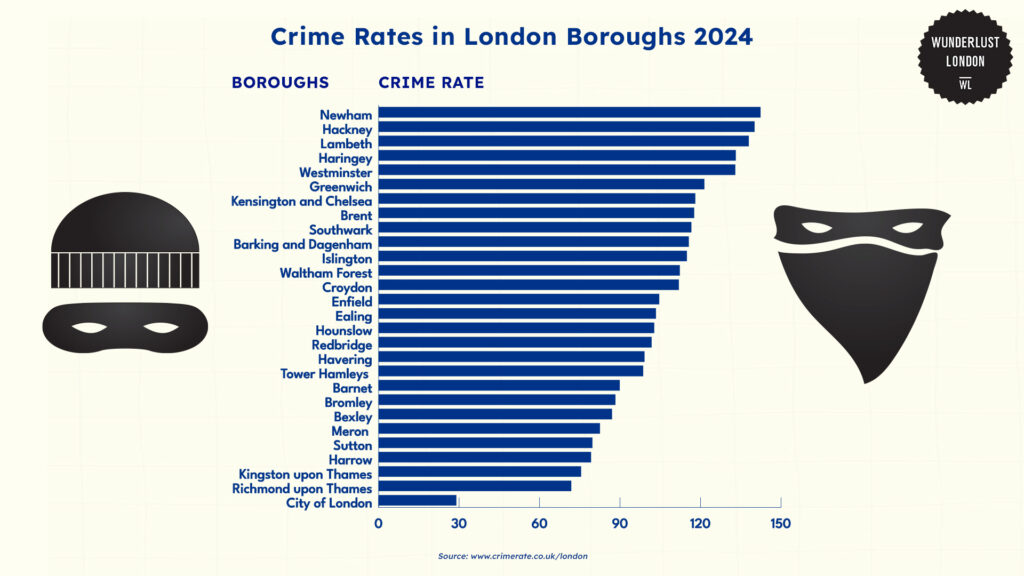
Based on the data provided by CrimeRate, Newham has the highest crime rate among London boroughs, with 142.35 crimes per 100,000 population.
Hackney follows closely, with a crime rate of 140.13.
In contrast, the lowest-ranked boroughs include the City of London and Richon upon Thames, with crime rates of 28.93 and 71.78, respectively.
These boroughs report crime rates significantly lower than those at the top of the list. This indicates regional differences in crime levels across London, such as population density, income inequality, and the presence of certain types of businesses or housing.
Demographic breakdown of crimes in London
Crime offences by gender in London
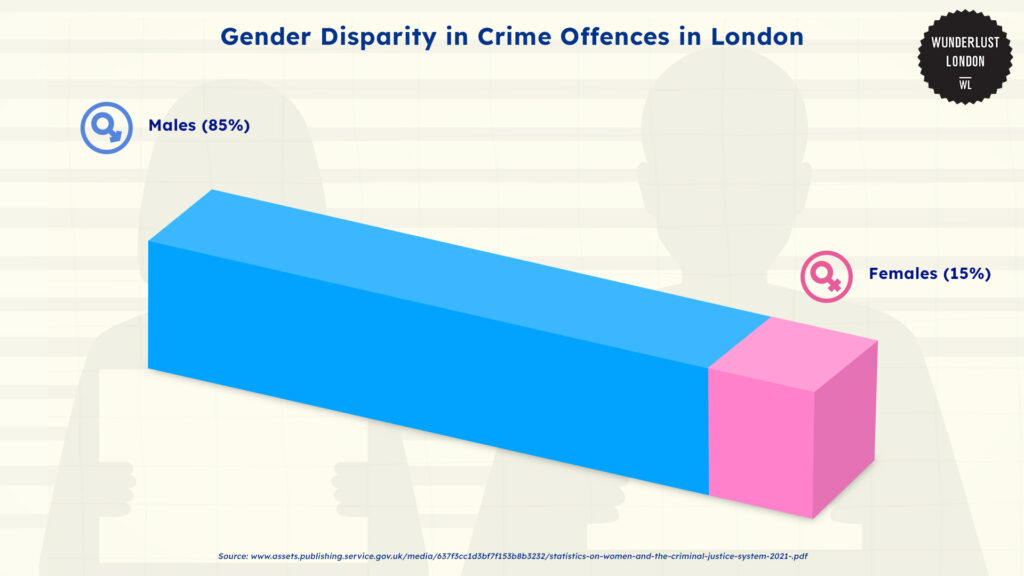
In the 2021 to 2022 period, the Ministry of Justice reports that males accounted for the vast majority (85%) of arrests. While the overall number of arrests decreased by 3% compared to 2019 to 2020, there was a slight increase of 2% in the most recent year.
As of June 30, 2022, males made up 96% of the prison population. The proportion of female prisoners has remained stable at 4% over the past five years.
Crime offences by time of day in London
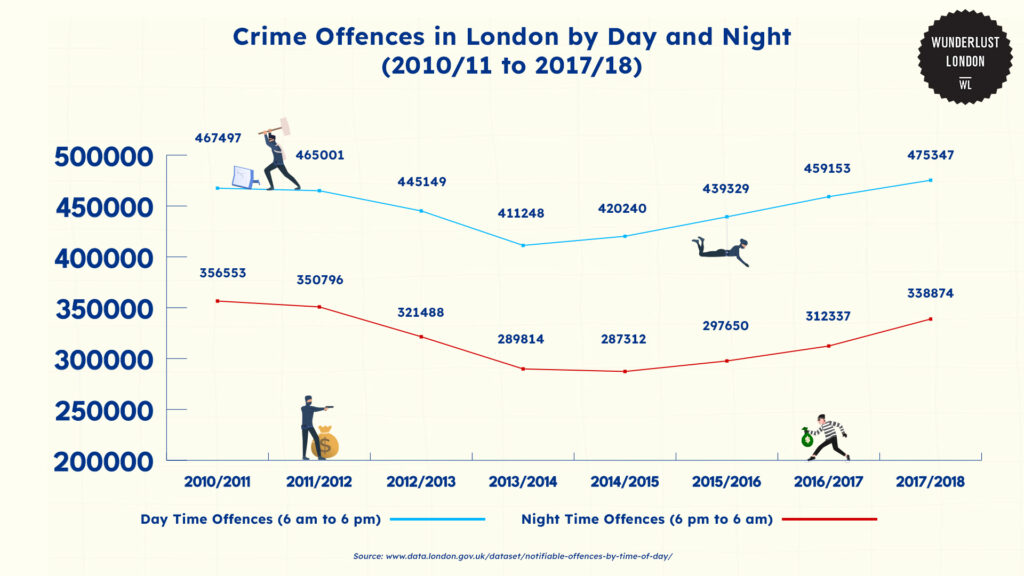
Between 2010/11 and 2017/18, the Metropolitan Police Service found that daytime crimes had slightly increased and now account for about 58-60% of all crimes.
Nighttime crimes also slightly increased but still only account for around 40-42% of total crimes.
Crimes in the evening (6 pm to midnight) dropped slightly but still make up about 25-26% of all crimes. Late-night crimes (midnight to 6 am), on the other hand, stayed steady at 15-17%.
Overall, while the total number of crimes has decreased slightly, the pattern of more crimes happening during the day has stayed the same.
The costs and consequences of crimes in London
- £2.3 billion decline in property values
- £20 million increased policing costs
- £5-10 million in emotional and psychological costs
Incorporate images related to crime.
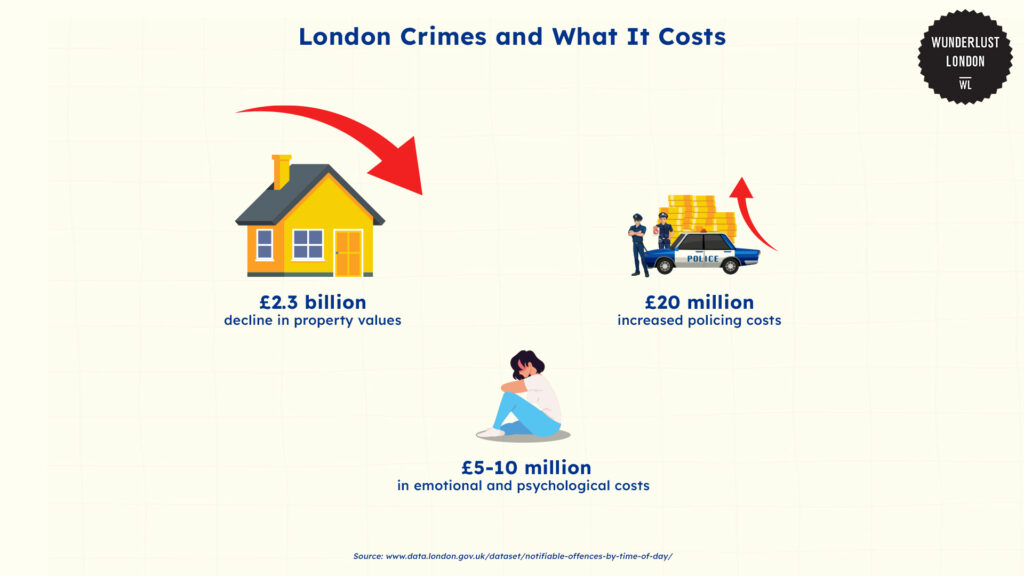
In London, the financial consequences of high crime rates are substantial. One significant cost is the decline in property values in affected boroughs.
A study by Steve Gibbons in 2004 states that properties can lose up to 10% of their value due to crime-related issues. In high-crime areas like Hackney and Newham, homeowners may face losses in property value amounting to over £2.3 billion collectively.
Additionally, the cost of increased policing adds a substantial burden. Boroughs with high crime rates require more law enforcement resources.
For instance, areas like Westminster and Hackney could spend up to £20 million per year on extra policing. These funds are essential to manage and reduce crime rates, but they strain local government budgets.
The emotional and psychological costs of living in high-crime areas also contribute to the financial impact.
As residents experience fear of crime, there is a noticeable rise in mental health issues, which leads to higher healthcare costs. The healthcare system could spend £5-10 million annually on treating anxiety, depression, and other mental health conditions related to crime.
Prison sentences for crimes in London
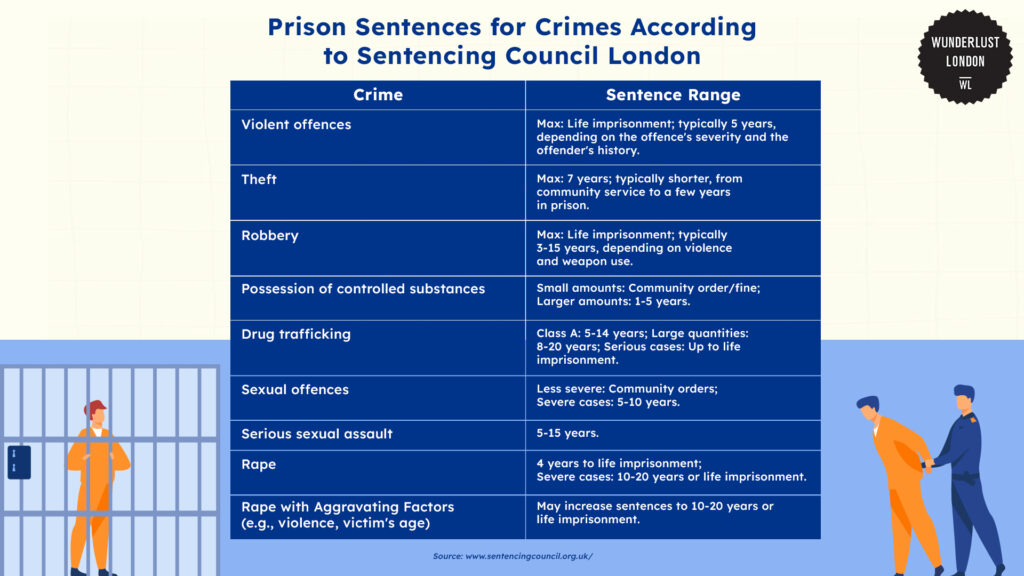
The Sentencing Council outlines various sentences for different crimes.
The sentence for violent crimes depends on the severity of the offence. Serious crimes, like murder, can result in life sentences. Sentences for less severe crimes can range from community service to several years in prison.
The maximum sentence for theft is seven years. Although, most offenders typically receive shorter sentences based on the value of the stolen items and the specifics of the crime.
When it comes to drug offences, possession can result in a fine or prison time. However, trafficking can lead to sentences from five years to life, depending on the type and quantity of drugs involved.
Sexual offences can lead to community orders or sentences ranging from 5 to 10 years for more severe cases.
In the case of rape, sentences span from 4 years to life imprisonment. There are aggravating factors, like violence or the victim’s age, that potentially result in much longer sentences.
London’s interventions and solutions to crimes
In March 2022, Mayor Sadiq Khan released his Police and Crime Plan for the current Mayoral term. This plan followed consultations with nearly 4,000 Londoners, crime victims, community groups, and businesses.
– Reducing and preventing violence
– Increasing public trust in the Metropolitan Police Service (MPS)
– Improving support for victims
– Protecting people from exploitation and harm
Incorporate images related to crime and include the Government of London as the source.
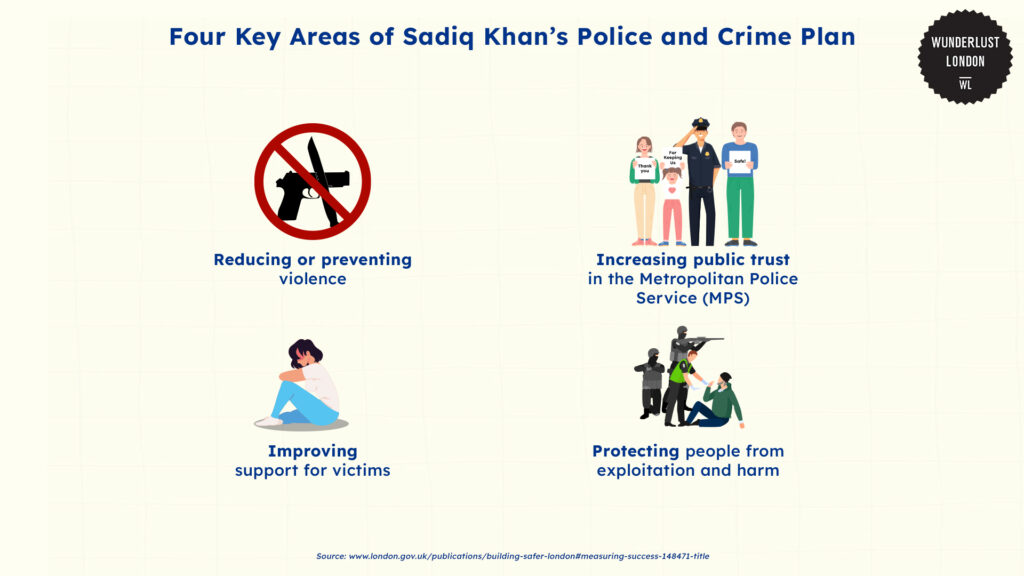
Reducing violence, particularly knife crime, is a top priority. With incidents rising in 2023/24, the plan focuses on early intervention and community engagement to prevent future violence.
Initiatives aimed at improving transparency and accountability in policing are also underway. This will help rebuild trust in the Metropolitan Police, especially in underserved communities.
The plan includes enhanced support services for victims, aiding physical and emotional recovery. It also emphasises protecting vulnerable populations from exploitation, including trafficking and abuse.
Despite a slight increase in homicides from 2023 to 2024, Statista reported 116 cases in London. However, the Metropolitan Police has reported a lower homicide rate compared to regions like the West Midlands.
Though knife crime was reduced in 2022/23, it rose again in 2023/24. It reached nearly 15,000 incidents, nearing pre-pandemic levels.
Khan’s plan is crucial in addressing these challenges and improving the safety and well-being of Londoners. He also outlined initiatives and funding details to improve the city’s conditions during his term.
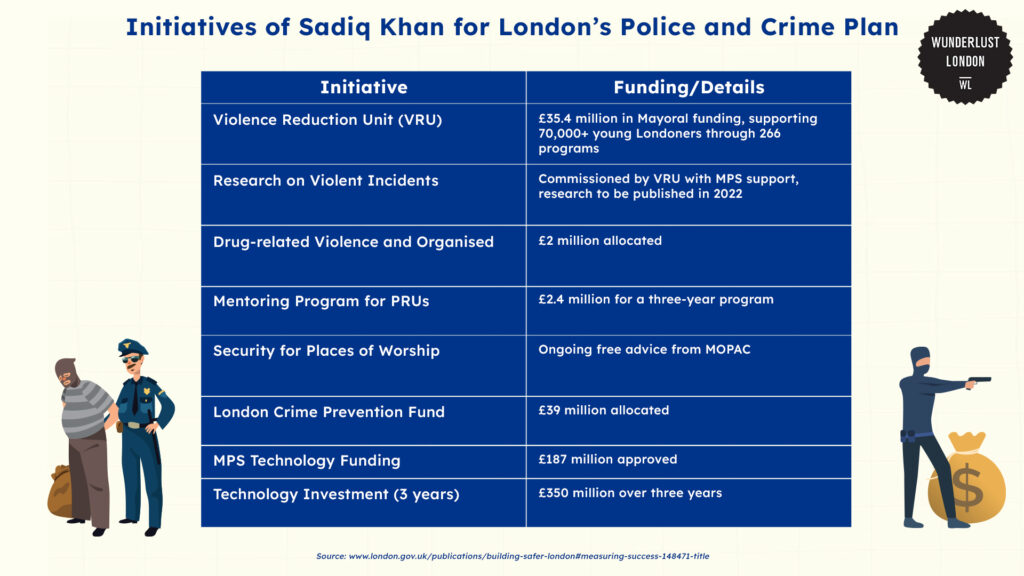
The Violence Reduction Unit (VRU) is working on a new strategy and researching violent incidents to better prevent them and support young people. They are also studying what leads to violence, which will help create better solutions.
A new mentoring program will also support students in Pupil Referral Units (PRUs). This is to help them stay engaged, motivated, and achieve their goals.
Additionally, the Mayor’s Office for Policing and Crime (MOPAC) will continue offering safety advice for places of worship until the government invests in training.
The London Crime Prevention Fund will support local authorities in delivering services and working together across boroughs.
The Mayor will also be investing in technology to improve the Metropolitan Police Service’s ability to keep Londoners safe. This includes investing in new digital systems to make services more efficient and accessible.
Knife crime and crime reduction strategies in London
When it comes to violence, London still faces challenges with rising knife crime.
The Office for National Statistics reported that knife-enabled crime recorded by the police increased by 7% in December 2023, reaching 49,489 offences.
Similar to London, cities like New York have experienced surges in violent crimes. This has prompted initiatives such as targeted police patrols and community engagement programs.
Operation Impact, launched by the New York Police Department in 2003, aims to reduce crime by deploying officers to high-crime areas known as “Impact Zones.”
London has taken steps in a similar direction. The implementation of the VRU focuses on early intervention and community support to reduce youth violence. The VRU works with schools, youth services, and local authorities to provide preventative measures.
Technological advancements like portable knife scanners and predictive policing are being explored.
The Metropolitan Police’s Digital Policing Strategy 2021-2025 outlines the use of technology to enhance policing capabilities, including the application of data analytics and facial recognition technologies.
- 2000s: Rising Knife Crime
- 2010s: Introduction of the Violence Reduction Unit (VRU)
- 2020s: Surge in Knife Crime
- 2023 and Beyond: Technological Advancements in Crime Prevention
Incorporate images related to crime
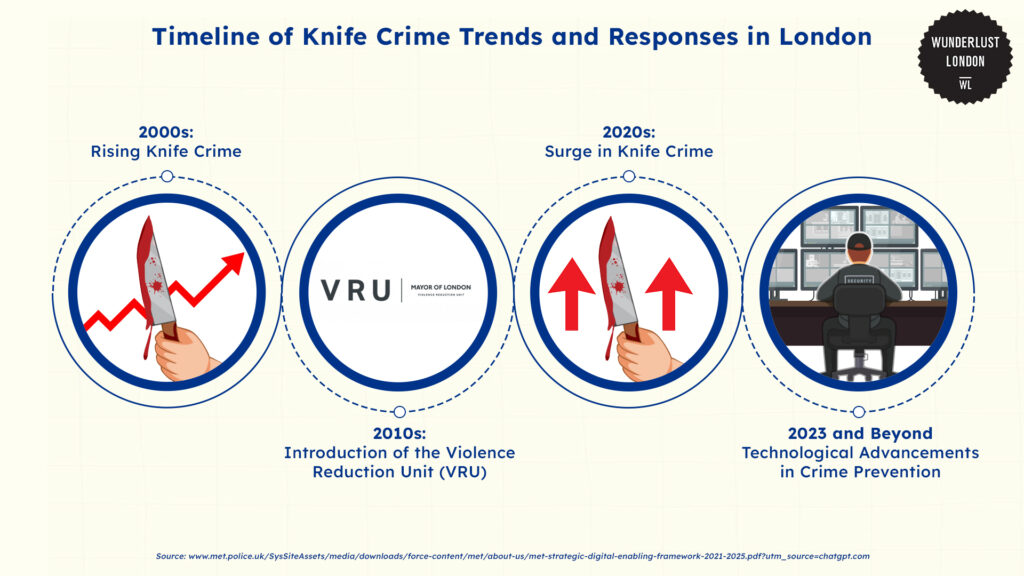
References
- Building a safer London. London City Hall. (2023). https://www.london.gov.uk/publications/building-safer-london#measuring-success-148471-title
- Clark, D. (2024). London homicides 2024 | Statista. https://www.statista.com/statistics/862984/murders-in-london/
- Clark, D. (2024). Topic: Crime in London. Statista. https://www.statista.com/topics/4627/crime-in-london/
- Digital Policing Strategy 2021-25 – London – Metropolitan police. (2021). https://www.met.police.uk/SysSiteAssets/media/downloads/force-content/met/about-us/met-strategic-digital-enabling-framework-2021-2025.pdf
- General theft. Sentencing. (n.d.). https://www.sentencingcouncil.org.uk/outlines/general-theft/
- Gibbons, S. (2004). Costs of urban property crime | The Economic Journal. Oxford Academic. https://academic.oup.com/ej/article-abstract/114/499/F441/5089327?redirectedFrom=fulltext
- London’s Police and Crime Plan 2022-25. London City Hall. (2024). https://www.london.gov.uk/programmes-strategies/mayors-office-policing-and-crime-mopac/keep-date-mopac-work/mopac-publications/londons-police-and-crime-plan-2022-25
- Metropolitan police notifiable offences by time of day. London Datastore News. (2021). https://data.london.gov.uk/dataset/notifiable-offences-by-time-of-day/
- Metropolitan Police. (n.d). Police and crime plan for London 2017 to 2021. https://www.met.police.uk/police-forces/metropolitan-police/areas/about-us/about-the-met/police-and-crime-plan/
- New York City Global Partners. (2008). New York City policy area: Safety and Security. http://www.nyc.gov/html/unccp/gprb/downloads/pdf/NYC_Safety and Security_Operation Impact.pdf
- ONS Centre for Crime and Justice. (2024). Crime in England and Wales: Year ending December 2023. Crime in England and Wales – Office for National Statistics. https://www.ons.gov.uk/peoplepopulationandcommunity/crimeandjustice/bulletins/crimeinenglandandwales/yearendingdecember2023?utm_source=chatgpt.com
- Statista Research Department. (2024). London crime figures 2024 | Statista. Statista. https://www.statista.com/statistics/864820/total-crime-offences-in-london/


